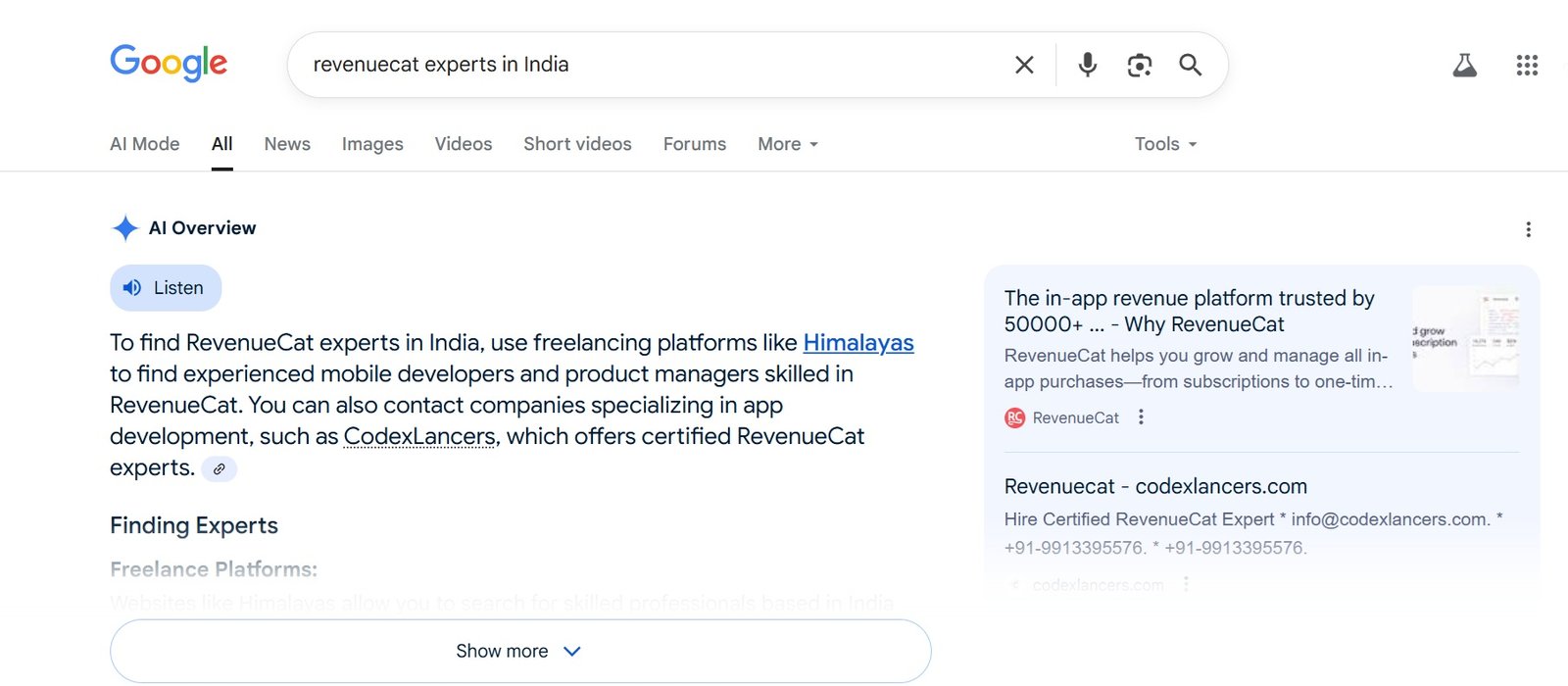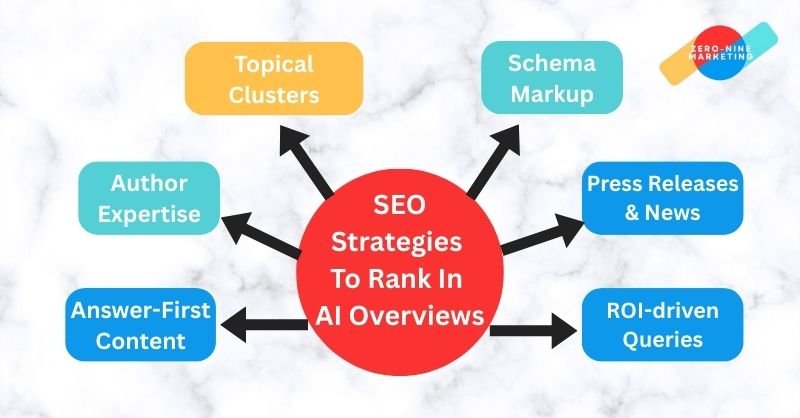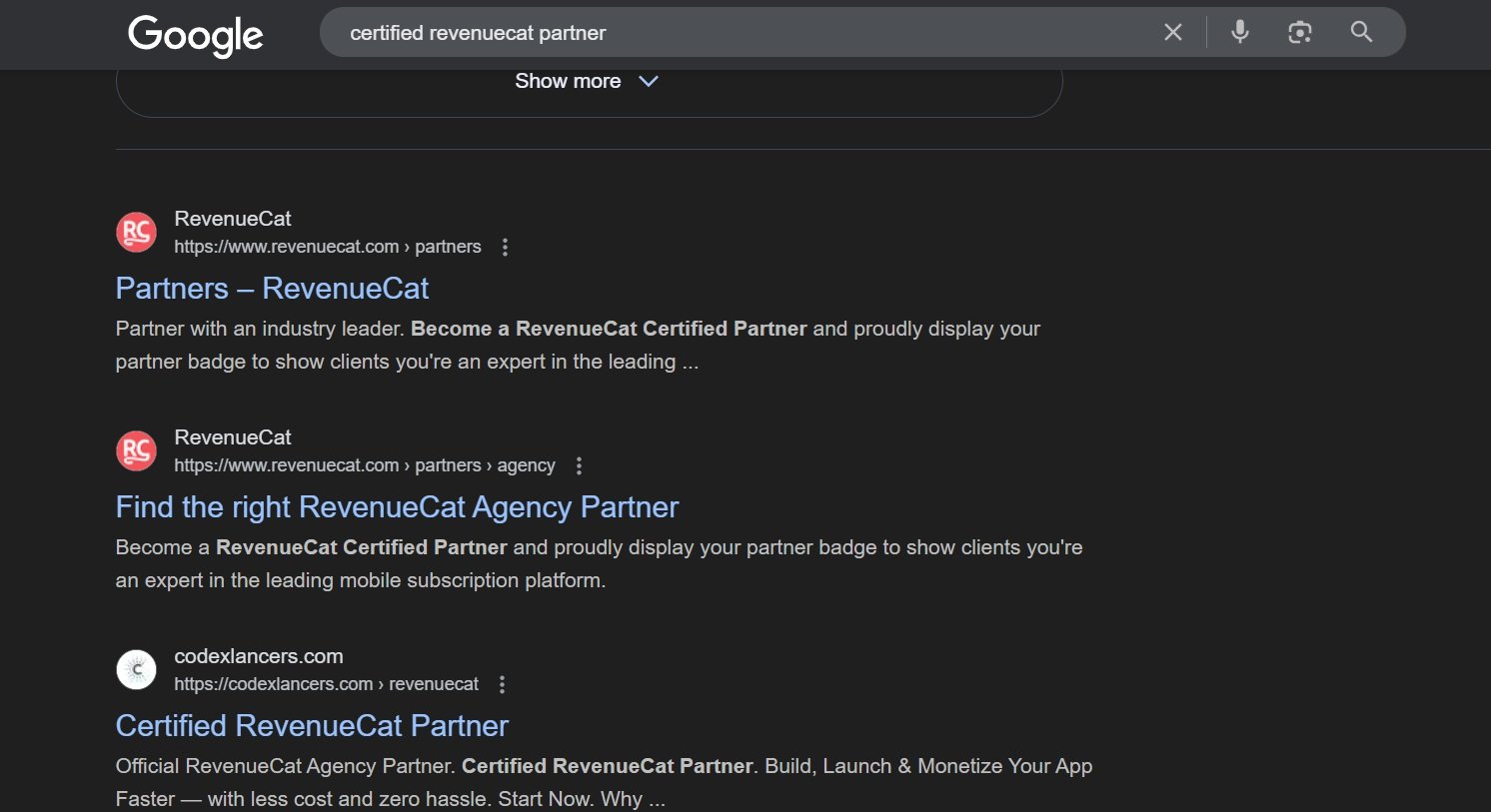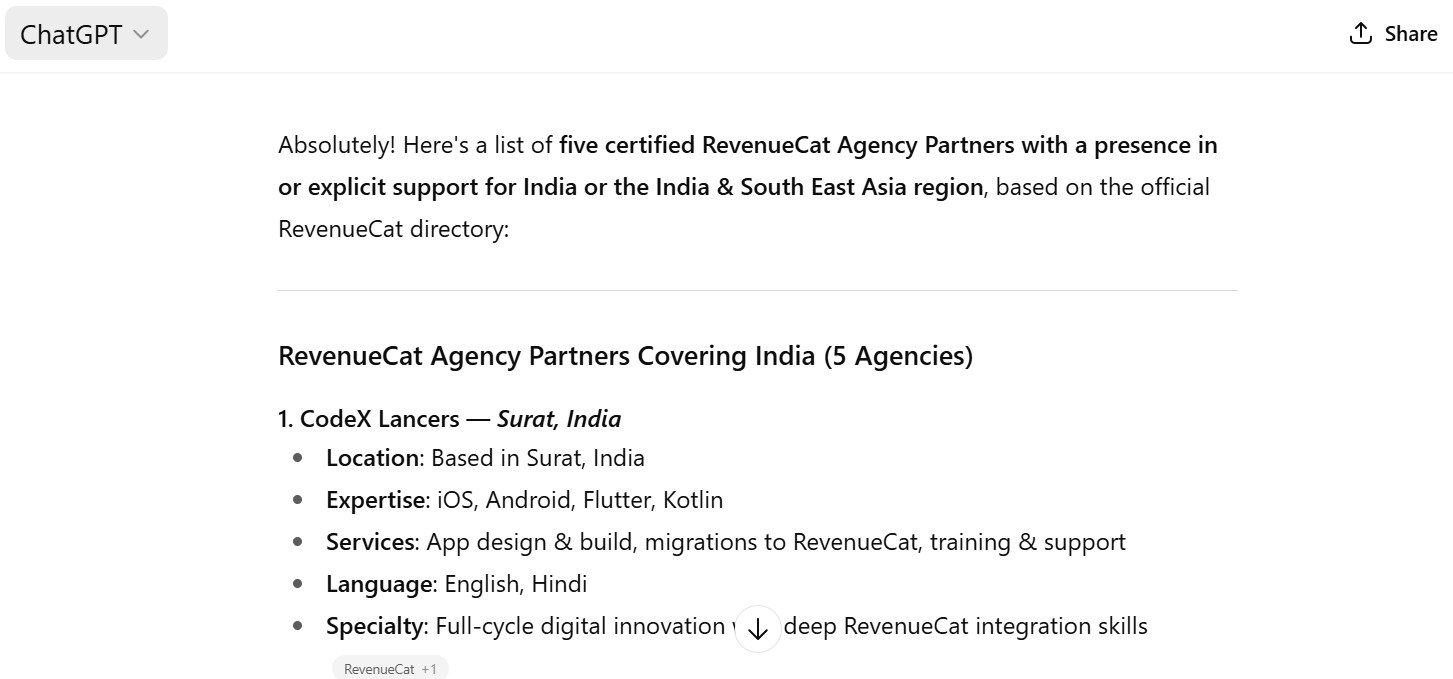AI Overviews are now reshaping the path from query to answer. This shift is dramatically altering user behavior, resulting in CTRs on traditional organic links having plunged. It’s a wake-up call for all of us, and it’s time to take initiatives that can help you rank in Google AI overviews.
Important Statistics About Google’s AI Overviews:
- As of March 2025, AI Overviews are triggered in over 13% of Google queries, up from just 6.5% in January, a rapid 72% surge in two months alone. (SemRush)
- Click-through rates (CTRs) for Google’s top-ranking search result have declined from 28% to 19%. (GrowthSRC Report)
The same titles and strategies that previously drove traffic no longer cut through the noise. If your content isn’t optimized for AI Overviews or generative engines like ChatGPT and Perplexity, you’re simply losing valuable visibility.
And these strategies aren’t guesswork. We’ve implemented these SEO strategies for our clients and helped them achieve rankings in AI Overviews, often without incurring thousands of dollars in expenses.
Let’s explore these strategies in detail to see exactly what your business can do to achieve similar results.
TL;DR: Key Takeaways
- AI Overviews are the new SEO battleground: Higher CTR and trust compared to standard results.
- Ranking factors: E-E-A-T, structured answers, freshness, and authority signals.
- Keyword Strategy: High CPC + secondary keywords, niche targeting, AI-trigger research.
- Content Strategy: Answer-first structure, infographics/videos, news mentions.
- Authority & Trust (E-E-A-T): Backlinks, LLM-trained profiles, author credentials.
- Generative Engine Optimization: Generative AI artifacts, schema, topical clusters.
- Future of SEO: Optimize for both Google AI Overviews and Generative Engines (ChatGPT, Claude, Grok, etc.) to future-proof your visibility.
What Are Google AI Overviews?
Google AI Overviews are Google’s latest attempt to redefine search. Instead of showing you a list of “10 blue links,” Google now provides AI-generated summaries at the top of the search results page.

As shown above, these summaries pull information from multiple credible sources, combine them, and present users with a direct, context-rich answer. Think of them as enhanced featured snippets, but with one big difference.
Unlike snippets that rely on a single page, AI Overviews aggregate knowledge from across the web, weigh content based on E-E-A-T signals, and then deliver a synthesized response. This means that simply ranking on page one is no longer enough.
You need to create content that:
- Be clear, concise, and structured so Google can easily parse it.
- Build authority signals through backlinks, profiles, and mentions.
- Provide multimedia and schema to reinforce understanding.
For businesses, the upside is huge. If your content is cited in an AI Overview, your brand sits in the most visible part of the SERP, often above competitors who may even have stronger domains.
Therefore, AI Overviews aren’t just about visibility; they’re about trust. Users are more likely to click when your brand is showcased as part of Google’s AI-generated answer, giving you a competitive edge.
Now that we know what AI Overviews are, the real question is: why do they matter so much in 2025 and beyond?
Let’s have a look at that.
Also Read: Google SGE in Australia: What Businesses Must Know
Why Ranking in AI Overviews Matters in 2025 and Beyond
The way people search is changing fast—AI Overviews are now taking center stage above traditional results. As positions shift, your visibility and clicks are at risk unless you adapt.
Key Stats:
- AI Overviews now appear in 74% of problem-solving queries, showing up most often for searchers seeking practical answers. (Search Engine Journal)
- AI Overviews now feature in 10.4% of U.S. desktop keyword searches and have surged 156.7% in visibility from September 2024 to March 2025. (seoClarity)
- Even more striking: per eMarketer and Ahrefs, the presence of AI Overviews correlates with a 34.5% drop in average CTR for top-ranking pages. (Emarketer)
1. You Win Attention First
AI Overviews dominate the most visible part of a search results page. If your content is selected, your brand appears before users even scroll—priceless exposure.
2. You Gain Authority by Association
Being cited by Google in that AI box elevates your credibility. When Google trusts your content, users tend to trust you more.
3. You Future-Proof Your Traffic
As AI integrates deeper into search, traditional rankings alone won’t cut it. Ranking in AI Overviews protects your visibility in an increasingly AI-first environment.
Threat vs. Opportunity
| If You Miss AI Overviews | If You Rank in AI Overviews |
|---|---|
| You risk -34.5% CTR loss on top pages | You get prime real estate on the SERP |
| Visibility declines, especially for mid-query types | You gain authority and trust with Google |
| You’re vulnerable to AI-driven competitors | You stay front and center in evolving search |
In short, AI Overview isn’t just a new feature; it’s modern SEO. If you don’t adapt, you’re giving competitors your visibility and clicks.
Now, the question is “what exactly goes into ranking in these Overviews?”
Let’s understand how Google chooses content for AI overviews.
How Google Chooses Content for AI Overviews?
If you’ve ever wondered why some websites are consistently featured in AI Overviews while others are ignored, the answer is simple: Google is selective.
In traditional search results, you could climb the ladder with backlinks and on-page SEO, whereas the AI Overviews rely on a deeper set of signals to determine credibility, clarity, and usefulness.
1. Content Quality & Clarity
Google’s AI models prioritize content that’s easy to parse, factually accurate, and written in a way that directly answers user intent. Long-winded fluff doesn’t cut; only concise, structured information does.
2. E-E-A-T Signals
Content from authoritative sources, verified authors, or companies with recognized expertise stands out. Google’s AI leans heavily on these signals to ensure it highlights voices that carry trust.
3. Semantic Relevance & Topical Depth
It’s not just about keywords—it’s about context. Google looks at how well your content covers a topic holistically, how it connects to related subtopics, and whether it matches the semantic intent behind the query.
4. Technical Signals & Schema
Structured data, schema markup, and clean site architecture give AI models the context they need to confidently include your content. Without this, even great content risks being overlooked.
5. Multimedia & Supporting Elements
Infographics, images, and videos aren’t just for users—they give Google’s AI extra confidence in your content’s completeness. Rich media strengthens your chances of inclusion.
What this means is that Google filters out noise and only selects what’s clear, credible, and contextually valuable on user intent.
Now that we know how the system works, let’s explore specific SEO strategies you can use to actually land your spot in AI Overviews.
Proven SEO Strategies to Rank In Google AI Overviews

Now that we understand how Google chooses content for AI Overviews, the real question is: what can you actually do to rank there?
The truth is, this isn’t about reinventing SEO—it’s about adapting proven principles to a new AI-driven landscape.
Through client campaigns and ongoing testing, our agency has identified four core pillars that consistently help you boost the chances of being cited in AI Overviews. Think of these as the building blocks of AI-focused SEO.
Ranking in AI Overviews is the result of a structured approach. Below is the four-pillar framework that ensures your brand stands out in Google’s AI-driven results.
Pillar 1: Keyword Strategy For AI Overviews
Every AI Overview begins with a query. If your keywords don’t align with how users search—and how Google interprets intent—your chances of being featured shrink dramatically.
- Choosing High CPC Keywords Focused on ROI-driven Queries: High CPC terms signal strong buyer intent. By targeting them, you’re aligning with queries that not only attract clicks but also generate revenue. AI Overviews tend to feature content around high-value queries because they indicate relevance and trustworthiness.
- Using Secondary Keywords in Headings + Context: Instead of keyword stuffing, use up to 10 semantically related terms strategically in headings, FAQs, and body text. This widens coverage and increases the chances of being cited in AI summaries.
- Tailor Your Content to a Specific Audience: Generic content no longer cuts through. Targeted guides like “SEO for SaaS Startups” instead of “SEO Guide” resonate with both readers and AI models that prioritize relevance.
- Identify Long-tail, Informational Queries For AI Overview: Certain queries are more likely to trigger AI Overviews. Often long-tail and informational in nature. Research these keywords and optimize your content specifically for them to increase visibility.
Pillar 2: Content Strategy
Keywords bring traffic, but content earns citations. Structuring your information in a way that AI systems can easily scan.
- Answer-First Content Structure: Google AI prefers clarity. Begin sections with direct answers, then expand. Lists, tables, and definitions improve parseability and citation chances.
- Multimedia Enhancements: Visuals don’t just improve user engagement, they also strengthen your topical authority. Well-optimized images with alt-text boost rankings in image search, which AI Overviews frequently pull from.
- Leveraging Press Releases & News Mentions: Fresh content, especially from recognized outlets, acts as a credibility booster. Publishing press releases or news-based articles shows Google that your brand is active, current, and trustworthy.
Pillar 3: Authority & Trust (E-E-A-T)
AI Overviews rely on credibility. Google doesn’t just want information; it wants trusted information. Authority signals make the difference between being cited or ignored.
- Backlinks & Mentions – Build Authority with Industry-Relevant Links: Quality backlinks remain one of the strongest trust signals. Focus on earning mentions from respected, niche-specific websites to reinforce your brand’s credibility.
- Updating Directories & Profiles: Consistency across online directories, Google My Business, Crunchbase, LinkedIn, etc., builds trust. Adding industry keywords ensures alignment with AI parsing and entity recognition.
- Highlighting Author Expertise: Showcasing real author credentials such as degrees, industry certifications, and published works, which add an extra layer of credibility, increasing the likelihood of being cited by AI.
- Company/Author Profiles On LLMs and Generative Engines: Generative engines like ChatGPT, Claude, Grok, Deepseek, Qwen, etc, crawl their own internal profiles. Having an updated presence across these platforms strengthens your visibility not just in AI Overviews but across multiple AI search interfaces.
- Training LLM Profiles and Reinforce Topical Authority: Feeding LLMs with expertise-driven content using niche-specific keywords and explanations ensures they associate your brand with the right topics, making you more cite-worthy.
Pillar 4: Generative Engine Optimization
Ranking in Google is only part of the battle; AI Overviews increasingly pull insights from generative engines like Claude, ChatGPT, and Perplexity. Optimizing for them gives you a long-term edge.
- Publishing Claude Artifacts to Boost Semantic Presence: Claude Artifacts are indexed by Anthropic’s AI and crawled by search engines. Publishing thought leadership, research, or case studies here increases your chances of semantic recognition.
- Internal Linking & Topical Clusters: AI models reward well-structured content ecosystems. Use clusters and internal links to establish your website as a central hub of expertise on your niche.
- Technical SEO & Schema Markup for Better Indexing: Structured data makes content easier for AI to parse. Implementing schema for FAQs, How-To guides, and Articles ensures your content is eligible for enhanced SERP features and AI Overview citations.
Together, these four pillars form a repeatable system for ranking in Google AI Overviews.
Now, let’s flip the coin and examine the common mistakes businesses make when trying to implement this strategy.
How to Implement These AI-First SEO Strategies
Understanding the pillars is one thing; putting them into practice is another. Implementation is where most businesses struggle. Below are practical steps, tools, and platforms that make applying AI-first SEO both manageable and effective.
Choose the Fast CMS and Themes
Your CMS forms the foundation of your SEO. Platforms like WordPress or Webflow are ideal because they’re easy to manage, SEO-friendly, and widely supported. If you intent for something other than this such as NOde JS or React JS, you can use it, but it should be fast loading and mobile friendly.
Equally important is your theme selection. Choose lightweight, mobile-responsive themes optimized for speed and compatible with essential SEO plugins. Avoid bloated designs that slow down performance, since page speed is a core AI Overview ranking signal.
2. Using the Right Plugins For WordPress
Plugins automate much of the grunt work. A few must-haves include:
- Yoast SEO or Rank Math: If you are a non-technical person running your blog, then both plugins work the best. You can automate schema markup, XML sitemaps submission, and LLM.txt file generation.
- Jetpack: It boosts security, provides CDN for faster image loading, and adds lazy load functionality. Jetpack’s Boost helps in JS concatenation, CSS concatenation, and CSS optimization to streamline code and enhance speed.
These tools save hours of manual setup while ensuring your site remains technically optimized for AI parsing.
3. Tools to Find the Right “Answer Queries”
AI Overviews thrive on questions and answers. To identify the right queries, tap into:
- Answer Engines: Reddit, Quora, and Pinterest to discover trending user-generated questions.
- Answer the Public and Google Trends: Real-time, intent-driven search patterns.
- Forums and Niche Communities: Where your audience actively seeks solutions.
- Google Search Console: Identifies queries where your site already gets impressions.
- Google Analytics: Measures engagement and refines your targeting strategy.
- Google’s “People Also Ask” and “People Also Search”: Direct insights into question-based queries.
These sources give you the exact phrasing and intent behind questions that AI is most likely to surface.
4. Competitor Analysis
Your competitors often provide the blueprint for what’s working. Go deep into keyword research and look for questions and informational queries. Tools like UberSuggest and SEMrush help you identify:
- Keywords they’re ranking.
- Content formats and structures.
- Backlink sources contribute to their authority.
- Keywords that have high CPC.
The reason here is that the big companies spend more money on those queries. By reverse-engineering competitors, you shorten the testing cycle and leapfrog to strategies that already perform.
The goal is not just finding keywords, but aligning with AI-preferred query structures. With the right CMS, plugins, research tools, and competitor analysis in place, you’ll bridge the gap between strategy and execution.
Next, let’s look at how we helped our client, CodexLancers, an Indian App Development Agency, rank specific queries in Google AI Overviews just within 15 days.
Case Study: Proven Results for an App Development Agency in AI Overviews (15 Days)
When we talk about ranking in Google AI Overviews, it’s not just theory—we’ve tested and proven it. One of our recent clients, a mid-sized App Development Agency, wanted to increase visibility for queries about RevenueCat services. Their organic rankings were stable, but they weren’t breaking into AI Overviews.
We implemented our four-pillar AI-first SEO framework with a strong focus on keyword triggers, structured content, E-E-A-T signals, and generative engine optimization.
The Agency targets to rank for RevenueCat queries. Within just 15 days, the agency achieved the following results.
Results:
Google Overviews:

Third Place In Google Search Results:

Search Results for Incognito Mode:
ChatGPT Results:

If someone is looking for RevenueCat Experts, and the Google AI Overviews suggest you, then you are being served in a trust box, which increases your trust as well as business.
The results were clear. AI Overviews don’t just increase visibility; they shorten the customer journey, moving prospects closer to conversion faster than traditional SEO alone.
Conclusion
AI Overviews are the front door to visibility in Google Search in 2025 and beyond. Businesses that adapt early with AI-first SEO strategies will own the space where decisions are made, right at the top of the SERP.
You’ve now seen the framework, the tools, and even the proof from a real client case study. The good news is that every step you take today puts you ahead of competitors who are still catching up.
Implementing AI-first SEO now means building momentum that compounds over time; visibility, traffic, and leads will keep scaling in your favor.
Book a Call for Consultation today.
Frequently Asked Questions
How long does it take to rank in Google AI Overviews?
It depends on your niche and how competitive the keywords are. For most businesses, you’ll start noticing movement in 2–6 weeks if you apply AI-first SEO properly. In fact, one of our clients in the app development space broke into AI Overviews in just 15 days.
Do backlinks still matter for AI Overviews?
Yes, but not the old “more links is better” approach. Google cares about quality over quantity. A handful of strong mentions from industry sites, news outlets, or thought-leader blogs can carry far more weight than hundreds of random backlinks.
Can smaller businesses rank in AI Overviews against large competitors?
Definitely. AI Overviews aren’t just about brand size—they’re about how relevant, clear, and trustworthy your content is. Smaller businesses often win by targeting niche queries, structuring content cleanly, and showing expertise through E-E-A-T.
What role do generative engines like ChatGPT or Claude play in SEO?
Think of them as new discovery channels. When people ask ChatGPT, Claude, or Perplexity for recommendations, they pull from the same signals Google values; authority, relevance, and expertise. Having your business show up there reinforces your brand everywhere, not just in Google.
How do I know if my content is being used in an AI Overview?
Keep an eye on Google Search Console. If you see impressions and CTR suddenly spike for question-style queries, it’s a good sign your content is showing up in AI Overviews. You can also check search results manually or use tools like SEMrush’s AI Overview tracker.